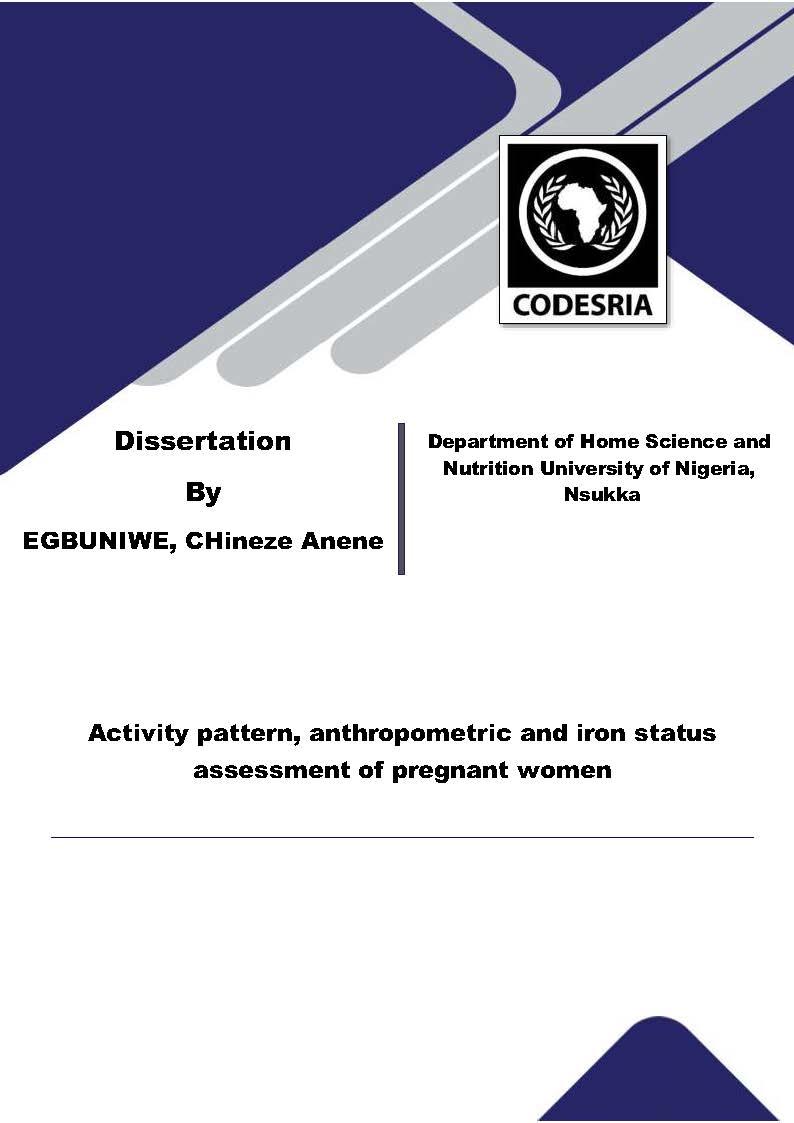Activity pattern, anthropometric and iron status assessment of pregnant women
Keywords:
Pregnancy, nutritive values, nutrition policy,, nutrition, anthropometry, maternal and childhealth,, nutrients, NigeriaSynopsis
Activity pattern, body mass index and iron status were studied during pregnancy. The results wereb obtained through questionnaire, 24-hour record of activities, height and weight measurements and biochemical analysis. A total of six hundred women were used for the study. Two hundred women each in Onitsha and Nsukka towns were used for the activity pattern study. Two hundred women were used for iron status study in Enugu town. Body mass index was found for all women in the three locations. Results of the study showed no statistical significance (p) 0.05) in activity pattern between the pregnant women living in Nsukka and Onitsha. Pregnant women allocated the longest time in their activity-time schedule to sleeping, which was not less than 9 hours. The time given to health care was 3.75 hours. In the third trimester, pregnant women slept longer than in the second trimester (t = 6.04; p < 0.001). Leisure time was higher in the third trimester than the second (t 2.57; p < 0.05). Time given to housecare was lower in the third trimester than in the second (t = 3.33; p ) 0.001). However, time for
shopping and food preparation was not different (p) 0.05) between the two trimesters. Pregnant housewives allocated more time to sleeping and leisure than other occupational groups, and less time to economic activities. Total household activities was performed more on weekends than weekdays (f = 22.47; p < 0.001).
Downloads
References
Adair, L.S., Pollitte, E. and Muèller, W.H. (1983). Maternal anthropometric changes during
pregnancy and lactation in rural Taiwanese population. Human Biology, 55, 771-787.
Adair, L.S. (1984). Marginal intake and maternal adaptation. The case of rural Taiwan. In energy
intake and activity, Pollitte,
E. and Amante, P. (eds.) Liss, R.A., New York.
Adair,·L. and Popkin, B.M. (1992). Prolonged lactation contributes to depletion of maternal energy
resources in Philippino women. Journal of Nutrition, 122: 1643-55.
Addo, A.A., Kareem, M.F., Sampson, T.I. and Jibrim, C.L. (1988). Anthropometric and nutrient intake
of Nigerian school children from different ecological zones. Ecology of food and nutrition,
, 271-285.
Allen, L.H., Lung'aho, M.S., Shaheen, M., Harrison, G.G., Neumann,
C. and Kirksey, (1994). BMI and pregnancy outcomes in nutrition CRSP. European Journal of Clinical
Nutrition, 48, Suppl. 3, 568-577.
Baker and De Maeyer (1977). Nutritional anaemia: Its understanding and control with specific
reference to work of WHO. American Journal of Clinical Nutrition, 32 (2), 368-414.
Barness, D.L., Adair, L. and Popkin, B.M. (1988). Women's physical
activjty and pregnancy outcome. A longitudinal analysis from the Philippines. Manuscript Carolina
Chapel Hill cited in McGuire, S.J. and Popkin (1990) Helping women improve Nutrition in Developing
World. World Bank Technic.al Paper, No.
, pl9.
Briend, A. (1979). Fetal stunting, fetal wasting and maternal nutritional status. In: Maternal
nutrition during pregnancy and lactation. Nestle Foundation Workshop (1980). Aebi, H. and
Whitehead, R. editors. Hans Huber Bern, Switzerland, plS0-159.
Charanjeek, H., Magai, V. and Pathak, V. (1988). Nutritional Intake of lactating Punjabi women.
Ecology of food and nutrition, 22:
-166.
Cole, A.H.; Ibeziako, P.A and Bamgboye, E.A. (1989) Basal metabolic rate and energy expenditure of
pregnant Nigerian women. British Journal of Nutrition, 62, 631-637.
Cook, J.D. and Finch, C.A. (1979). Assessing iron status of a population. American Journal of
Clinical Nutrition, 32:·115-7.
De Maeyer, E.M. (1981). The role of WHO in the control of nutritional anaemia. In: Maternal
nutrition information for action resource guide. World Federation of Public Health Association,
U.S.A. p. 22.
De Maeyer, E.M. (1989). Preventing and controlling iron deficiency
anaemia through primary health care. In: Iron supplementation
during pregnancy: Why aren' t women complying? A review of available information.
WHO/MCH/90.5, Geneva, p. 8.
De Maeyer, E.M. (1989) .Preventing and controlling iron deficiency
anaemia through primary heal th care. A guide for heal th administrators and programme
managers. World Health Organisation Monograph, WHO, Geneva
De Maeyer, E.M. and Adiels-Tegman, M. (1985-). Prevalence of anaemia in the world. World
Health Statistics, Q 38 (3): 302-316.
Durnin, J.V.G.A. (1987). Energy requirement of pregnancy an
integral of the longitudinal data from the five country study. Lancet 14: 1131-33.
Durnin, J.V.G.A. (1987). Energy requirement of pregnancy I/D/E/C/G, 1987. Guatamala City, p. 60-75.
Durnin, J.V.G.A. (1991). Energy requirement of pregnancy. Acta Paediatrics. Secandal
Supplement, 373: 33-44.
Ene-Obong, H.N. (1984). Market Index Consumption patterns and contribution of cowpea
legumes to the nutrient intakes of selected communi ties around Nsukka. Unpublished the
sis for award of M.Sc. in Home Science and Nutrition, University of Nigeria, Nsukka.
Engle, P.C. (1989). Child care strategies of working and non working women in rural
andurban Guatamala. In women work and
child welfare in the third world. American Association for






